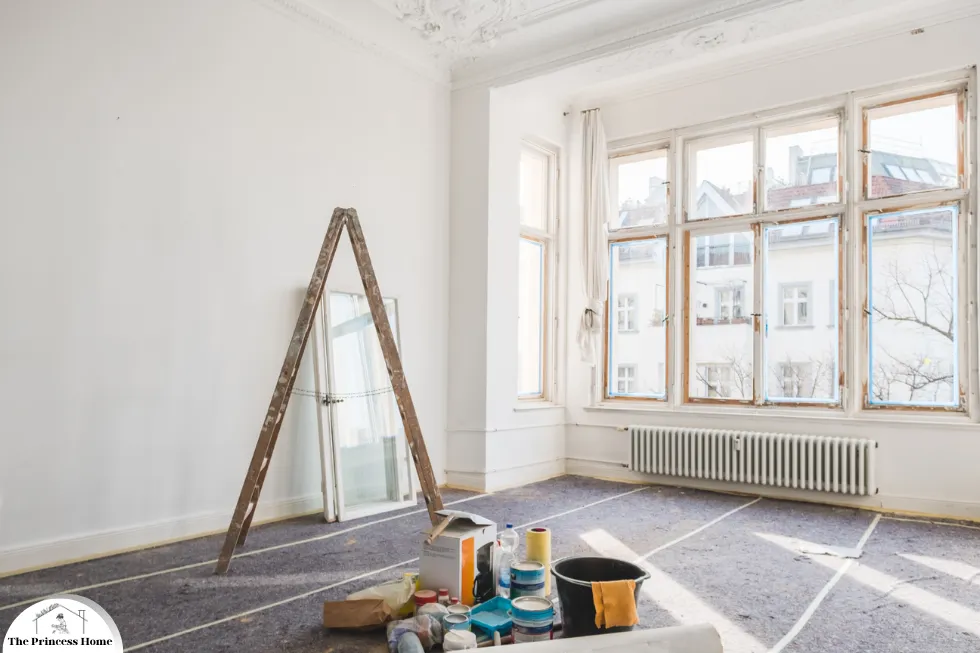
Embarking on a home renovation project is an exciting endeavor. Whether you’re updating your kitchen, remodeling your bathroom, or giving your entire home a makeover, setting a budget is crucial to ensure the project stays on track financially. A well-planned budget not only helps you manage costs but also allows you to prioritize spending on areas that matter most to you.
In this comprehensive guide, we’ll walk you through the essential steps to effectively set a budget for your home renovation project.

1*.Assess Your Needs &Goals:
Before diving into the financial aspect, take the time to assess your renovation needs and goals. What aspects of your home do you want to improve? Are you focusing on aesthetics, functionality, or both? Understanding your priorities will help you allocate your budget more effectively. Make a list of all the renovations you wish to undertake, from major structural changes to minor cosmetic updates.
Assessing your renovation needs and goals is the crucial first step in setting a budget for your home renovation project. This process involves evaluating your current living space, identifying areas that require improvement, and defining your objectives for the renovation.
Here’s a detailed breakdown of how to assess your needs :
1.Evaluate Your Current Living Space:
- Take a comprehensive walkthrough of your home, room by room, to identify areas that need attention.
- Note any structural issues, safety concerns, or functionality problems that need to be addressed.
- Consider the overall flow and layout of your home and whether it meets your lifestyle needs and preferences.
2.Identify Improvement Areas:
- Determine which aspects of your home you want to improve through the renovation.
- Consider both practical needs and aesthetic preferences when identifying improvement areas.
- Common areas for renovation include kitchens, bathrooms, bedrooms, living rooms, outdoor spaces, and structural elements like roofing, windows, and insulation.
3.Define Your Objectives:
- Clarify your goals for the renovation project and what you hope to achieve by the end.
- Are you looking to increase living space, enhance comfort and functionality, update outdated features, or improve energy efficiency?
- Consider whether you’re primarily focusing on aesthetics, functionality, or a balance of both.
- Think about your long-term plans for the property and how the renovation fits into your overall vision.
4.Prioritize Renovation Needs:
- Once you’ve identified improvement areas and defined your objectives, prioritize them based on urgency, importance, and budgetary constraints.
- Separate essential renovations that address safety, structural integrity, and functionality from optional upgrades and cosmetic enhancements.
- Consider the potential impact of each renovation on your daily life, resale value, and overall satisfaction with your home.
5.Make a Comprehensive Renovation List:
- Create a detailed list of all the renovations you wish to undertake, categorizing them by room or area of the house.
- Include both major structural changes and minor cosmetic updates on your renovation list.
- Break down each renovation into specific tasks or components to ensure nothing is overlooked during the planning and budgeting process.
By thoroughly assessing your renovation needs and goals, you can gain a clear understanding of what you want to accomplish with your home renovation project. This foundational step will inform your budgeting decisions and help you prioritize spending on areas that align with your objectives and deliver the greatest value and satisfaction in the end.

2*.Research &Gather Quotes:
Once you have a clear idea of your renovation goals, it’s time to research and gather quotes from contractors, architects, and other professionals you may need to hire. Reach out to multiple service providers to compare prices and get a realistic understanding of the costs involved. Be sure to ask for detailed estimates that include materials, labor, permits, and any other expenses. Researching and gathering quotes from contractors, architects, and other professionals is a crucial step in the home renovation process.
Here’s a detailed guide on how to effectively conduct this research and obtain accurate quotes:
1.Identify Potential Service Providers:
- Start by researching reputable contractors, architects, designers, and other professionals in your area who specialize in the type of renovation you’re planning.
- Seek recommendations from friends, family, neighbors, and online review platforms to compile a list of potential service providers.
2.Verify Credentials &Experience:
- Before reaching out for quotes, verify the credentials, licenses, and certifications of each service provider.
- Check their experience, portfolio of past projects, and client testimonials to ensure they have the expertise and track record of delivering quality work.
3.Request Detailed Estimates:
- Contact each service provider on your list and request detailed estimates for your renovation project.
- Provide them with clear specifications, plans, and any relevant information to ensure accurate quotes.
- Ask for itemized estimates that break down costs for materials, labor, permits, and any additional expenses.
4.Compare Quotes:
- Once you’ve gathered quotes from multiple service providers, carefully compare them to identify differences in pricing, scope of work, and included services.
- Look beyond the total cost and evaluate the breakdown of expenses to understand where your money is being allocated.
- Pay attention to any discrepancies or omissions in the quotes and seek clarification from the service providers if necessary.
5.Evaluate Reputation &Reliability:
- Consider more than just price when evaluating quotes; also assess the reputation, reliability, and professionalism of each service provider.
- Look for contractors and professionals who communicate clearly, respond promptly to inquiries, and have a history of completing projects on time and within budget.
- Check online reviews, ratings, and references to gauge customer satisfaction and reliability.
6.Negotiate Terms and Pricing:
- Once you’ve narrowed down your options, don’t hesitate to negotiate terms and pricing with the service providers.
- Discuss any areas where you feel the quote could be adjusted or revised to better align with your budget and needs.
- Be open to compromise and flexibility while ensuring that you’re getting value for your money.
7.Finalize Contracts:
- After selecting a service provider, finalize the contract detailing the scope of work, timelines, payment schedule, and any other relevant terms and conditions.
- Ensure that all agreements are documented in writing to avoid misunderstandings or disputes later on.
- Review the contract carefully before signing and seek legal advice if needed to ensure your interests are protected.
By conducting thorough research and gathering quotes from multiple service providers, you can make informed decisions and choose the right professionals for your home renovation project. This diligence will help you secure competitive pricing, quality craftsmanship, and a smooth renovation process from start to finish.

3*.Factor in Contingencies:
No matter how meticulously you plan, home renovations often come with unexpected surprises and additional costs. It’s essential to factor in contingencies when setting your budget to account for unforeseen circumstances such as structural issues, hidden damages, or design changes. A common rule of thumb is to set aside an additional 10-20% of your total budget for contingencies.
Factoring in contingencies is a prudent practice when setting a budget for a home renovation project. Unforeseen circumstances such as structural issues, hidden damages, or design changes can arise during the renovation process, leading to additional costs and delays.
Here’s how to effectively factor in contingencies to ensure your budget remains realistic and manageable:
1.Assess Potential Risks &Unknowns:
- Before setting your budget, carefully assess the potential risks and unknowns associated with your renovation project.
- Consider the age and condition of your home, the complexity of the renovations, and any previous issues that may affect the project.
- Anticipate potential challenges such as outdated wiring, plumbing problems, or structural weaknesses that may require additional work and expenses.
2.Determine Contingency Percentage:
- As a general rule of thumb, set aside an additional 10-20% of your total budget to cover contingencies.
- The specific percentage may vary depending on the scale and scope of your renovation, as well as the level of risk involved.
- For larger or more complex projects, you may want to lean towards the higher end of the contingency range to account for potential challenges.
3.Incorporate Contingencies Into Budget:
- Add the contingency percentage to your initial budget calculations to create a buffer for unexpected expenses.
- For example, if your estimated renovation costs are $50,000, setting aside 10-20% for contingencies would add an additional $5,000-$10,000 to your budget.
- Ensure that the contingency funds are included in your overall renovation budget and are not earmarked for specific expenses to provide flexibility as needed.
4.Communicate With Contractors &Professionals:
- Discuss the importance of contingencies with your contractors, architects, and other professionals involved in the renovation project.
- Make sure they understand the need for flexibility in the budget to accommodate unforeseen circumstances and unexpected expenses.
- Encourage open communication throughout the renovation process to promptly address any issues that arise and adjust the budget accordingly.
5.Prioritize Contingency Spending:
- If unforeseen expenses do arise during the renovation, prioritize spending from the contingency fund to address urgent needs and essential repairs.
- Evaluate each additional cost against the impact it will have on the overall project and prioritize expenses accordingly.
- Use the contingency fund strategically to maintain progress on the renovation while minimizing disruptions and staying within budget constraints.
6.Monitor &Adjust Budget as Needed:
- Regularly monitor your renovation budget throughout the project to track expenses and assess the status of the contingency fund.
- Be prepared to adjust the budget as needed to accommodate unforeseen expenses or changes in scope.
- Maintain clear records of all expenditures and update your budget accordingly to ensure transparency and accountability.
By factoring in contingencies and setting aside a buffer for unexpected expenses, you can mitigate the financial risks associated with home renovations and ensure that your project stays on track and within budget. This proactive approach will provide peace of mind and help you navigate any challenges that may arise during the renovation process.

4*.Determine Your Financing Options:
Once you have a rough estimate of the renovation costs, consider your financing options. Are you planning to pay for the renovation out of pocket, or will you need to explore loan options? If you’re taking out a loan, research different financing options such as home equity loans, personal loans, or lines of credit, and choose the one that best suits your financial situation and renovation plans. Determining your financing options is a crucial step in the home renovation planning process, especially once you have a rough estimate of the renovation costs.
How to assess your financing options :
1.Assess Your Financial Situation:
- Begin by evaluating your current financial position, including your income, savings, and existing debts.
- Calculate how much you can afford to allocate towards the renovation project without jeopardizing your financial stability or long-term financial goals.
2.Determine the Renovation Budget:
- Use the estimated renovation costs as a benchmark to determine how much financing you’ll need to complete the project.
- Consider factors such as labor, materials, permits, contingencies, and any other associated expenses when calculating the total budget.
3.Evaluate Payment Options:
- Decide whether you’ll pay for the renovation out of pocket or explore financing options to cover all or part of the expenses.
- If paying out of pocket, ensure that you have sufficient savings earmarked for the renovation and other financial priorities.
- If opting for financing, research the various payment options available to you and weigh their pros and cons.
4.Research Financing Options:
- Research different financing options available for home renovations, including home equity loans, personal loans, lines of credit, and renovation mortgages.
- Compare interest rates, terms, fees, and repayment options for each financing option to determine which aligns best with your needs and preferences.
- Consider factors such as loan amounts, repayment periods, and flexibility in accessing funds when evaluating financing options.
5.Explore Home Equity Options:
- If you have significant equity in your home, consider leveraging it to finance your renovation through a home equity loan or home equity line of credit (HELOC).
- Home equity loans offer a lump sum payment with a fixed interest rate and predictable monthly payments, while HELOCs provide a revolving line of credit with variable interest rates and flexible withdrawal options.
6.Consider Personal Loans:
- Personal loans are another option for financing home renovations, particularly for smaller projects or when you don’t have sufficient home equity.
- Personal loans typically have fixed interest rates and repayment terms, making them a straightforward financing option for budget-conscious homeowners.
7.Evaluate Lines of Credit:
- Lines of credit, such as personal lines of credit or credit cards, can provide flexibility in accessing funds for home renovations as needed.
- However, be mindful of higher interest rates and potential fees associated with lines of credit, and only borrow what you can comfortably repay.
8.Seek Professional Advice:
- If you’re unsure about the best financing option for your renovation project, consider seeking advice from a financial advisor or mortgage specialist.
- A professional can help you assess your financial situation, explore financing options, and choose the most suitable solution based on your individual circumstances and goals.
9.Apply for Financing:
- Once you’ve chosen a financing option, gather the necessary documentation and submit your application to the lender.
- Be prepared to provide information about your income, assets, debts, and credit history to support your application.
- Review the terms and conditions of the loan carefully before signing and ensure that you understand the repayment obligations and any associated fees.
By carefully assessing your financing options and choosing the one that best suits your needs and financial situation, you can secure the necessary funds to complete your home renovation project while minimizing financial stress and maximizing the value of your investment.

5*.Set Priorities &Allocate Funds:
With a clear understanding of your renovation needs, costs, and financing options, it’s time to set priorities and allocate funds accordingly. Determine which aspects of the renovation are non-negotiable and where you’re willing to compromise if necessary.
Allocate funds to each component of the project, ensuring that essential items are adequately funded while leaving room for flexibility in other areas. Setting priorities and allocating funds effectively is essential for ensuring that your home renovation project stays on track and within budget.
How to set priorities and allocate funds for your renovation:
1.Review Renovation Needs and Goals:
- Begin by revisiting your renovation needs, goals, and budget to refresh your understanding of the project scope and objectives.
- Consider the results of your assessment, research, and financing decisions to inform your prioritization and fund allocation process.
2.Identify Non-Negotiables:
- Determine which aspects of the renovation are non-negotiable and essential for achieving your goals.
- Non-negotiables may include critical repairs, safety improvements, functionality upgrades, or features that align with your long-term vision for your home.
3.Rank Priorities:
- Rank the remaining renovation components based on their importance, urgency, and alignment with your overall goals and budget.
- Consider factors such as impact on daily living, potential return on investment, and personal preferences when prioritizing renovation tasks.
4.Allocate Funds:
- Allocate funds to each renovation component based on its priority and estimated cost.
- Start by allocating funds to non-negotiable items to ensure they receive sufficient funding to be completed satisfactorily.
- Distribute remaining funds among lower-priority tasks, considering their relative importance and potential impact on the overall project.
5.Create a Budget Breakdown:
- Create a detailed budget breakdown that outlines how funds will be allocated to each renovation component.
- Divide the budget into categories such as materials, labor, permits, contingencies, and miscellaneous expenses to track spending accurately.
6.Consider Flexibility:
- Build flexibility into your budget by leaving room for adjustments and unforeseen expenses.
- Allocate a portion of the budget to contingencies to cover unexpected costs or changes in scope without derailing the project.
7.Optimize Cost-Efficiency:
- Look for opportunities to optimize cost-efficiency and maximize value within each renovation component.
- Research cost-effective alternatives, negotiate prices with contractors and suppliers, and explore DIY options where feasible to stretch your budget further.
8.Review and Refine:
- Regularly review and refine your budget allocation as the renovation progresses and new information becomes available.
- Monitor spending, track progress, and adjust allocations as needed to ensure that funds are allocated effectively and in line with project priorities.
9.Communicate With Contractors:
- Communicate your budget priorities and allocation decisions clearly with contractors, subcontractors, and other professionals involved in the renovation.
- Set expectations regarding budget constraints and priorities to avoid misunderstandings and ensure alignment throughout the project.
10.Stay Flexible:
- Remain flexible and adaptable throughout the renovation process, as unexpected challenges or opportunities may arise.
- Be prepared to reallocate funds or adjust priorities as needed to address changing circumstances and optimize project outcomes.
By setting priorities and allocating funds thoughtfully and strategically, you can ensure that your home renovation project stays within budget while achieving your desired results and maximizing the value of your investment. Regularly reassessing priorities and budget allocations will help you stay on track and make informed decisions throughout the renovation process.

6*.Track Expenses &Adjust as Needed:
Once the renovation is underway, it’s crucial to track expenses closely and adjust your budget as needed. Keep a detailed record of all expenditures, including materials, labor, permits, and any unexpected costs that arise along the way.
Regularly review your budget to ensure you’re staying on track and make adjustments as necessary to avoid overspending. Tracking expenses and adjusting your budget as needed is essential for managing costs effectively and ensuring that your home renovation project stays within budget.
How to track expenses and make necessary adjustments:
1.Establish a Tracking System:
- Choose a method for tracking expenses that works best for you, whether it’s using a spreadsheet, budgeting software, or a dedicated renovation app.
- Create categories for different types of expenses, such as materials, labor, permits, and miscellaneous costs, to organize your spending effectively.
2.Record All Expenses:
- Keep a detailed record of all expenses related to the renovation, including receipts, invoices, and payment confirmations.
- Enter each expense into your tracking system promptly to ensure accuracy and completeness.
3.Monitor Spending:
- Regularly review your expense tracking system to monitor spending and track how funds are being allocated across different categories.
- Compare actual expenses to your budget allocations to identify any discrepancies or areas where spending is exceeding projections.
4.Identify Variance:
- Identify any variances between your budgeted expenses and actual spending to pinpoint areas where adjustments may be needed.
- Pay attention to significant cost overruns, unexpected expenses, or discrepancies that may require immediate attention.
5.Analyze Reasons for Variance:
- Analyze the reasons for variance between budgeted expenses and actual spending to understand the underlying factors driving the discrepancies.
- Determine whether variances are due to unforeseen circumstances, changes in scope, supplier price increases, or other factors beyond your control.
6.Make Adjustments:
- Based on your analysis, make necessary adjustments to your budget to address variances and ensure that your renovation project remains financially viable.
- Allocate additional funds to categories where spending exceeds projections or reallocate funds from lower-priority areas to cover unexpected expenses.
7.Prioritize Spending:
- Prioritize spending on essential items and critical aspects of the renovation to ensure that key objectives are met within budget constraints.
- Consider deferring non-essential expenses or discretionary upgrades if funds are limited or if unexpected costs arise.
8.Communicate With Contractors &Suppliers:
- Communicate any budget adjustments or changes in spending priorities with contractors, subcontractors, and suppliers involved in the renovation.
- Keep them informed of any updates to the budget to ensure alignment and avoid misunderstandings during the project.
9.Continue Tracking:
- Maintain diligent expense tracking throughout the renovation process, continuing to record all expenditures and update your budget as needed.
- Regularly review and reconcile your expense tracking system to ensure accuracy and completeness.
10.Seek Professional Advice:
- If you’re unsure about how to handle budget adjustments or need assistance with financial management, consider seeking advice from a financial advisor or renovation professional.
- They can provide guidance on managing costs effectively and making informed decisions to keep your renovation project on track financially.
By tracking expenses closely and adjusting your budget as needed, you can effectively manage costs, avoid overspending, and ensure the success of your home renovation project. Regular monitoring and proactive adjustments will help you stay on track and achieve your renovation goals within your budget constraints.

7*.Don’t Forget About Long-Term Costs:
When setting your budget, don’t overlook long-term costs associated with maintenance, utilities, and potential increases in property taxes. Investing in energy-efficient appliances, fixtures, and materials may result in higher upfront costs but can lead to long-term savings on utility bills. Consider these factors when making decisions about where to allocate your budget.
Considering long-term costs is critical when setting a budget for a home renovation project. While it’s essential to focus on immediate expenses, overlooking long-term costs associated with maintenance, utilities, and potential increases in property taxes can impact your finances in the future.
Here’s how to ensure you account for long-term costs when allocating your renovation budget:
1.Maintenance Expenses:
- Factor in ongoing maintenance costs associated with the renovations you’re planning. Certain materials and features may require more upkeep and maintenance than others.
- Choose durable, low-maintenance materials and fixtures that can withstand wear and tear over time, reducing the need for frequent repairs and replacements.
- Allocate a portion of your renovation budget towards establishing a maintenance fund to cover future upkeep and repairs.
2.Utilities & Energy Efficiency:
- Consider the long-term impact of your renovation choices on utility bills and energy consumption.
- Invest in energy-efficient appliances, fixtures, and materials that can help lower utility costs and reduce your environmental footprint.
- Look for ENERGY STAR certified products and materials that meet high standards for energy efficiency and performance.
- Calculate potential savings on utility bills over the lifespan of the renovated components to justify higher upfront costs for energy-efficient upgrades.
3.Property Taxes:
- Be aware of potential increases in property taxes resulting from the renovation, particularly if the project adds significant value to your home.
- Research local tax laws and regulations to understand how renovations may affect property assessments and tax assessments in your area.
- Consult with a real estate professional or tax advisor to estimate the potential impact of the renovation on your property taxes and factor this into your budget planning.
4.Allocate Budget Appropriately:
- When allocating your renovation budget, prioritize investments in energy-efficient upgrades and low-maintenance features that offer long-term cost savings.
- Balance upfront costs with potential long-term benefits, considering the return on investment and overall value added to your home.
- Allocate a portion of your budget specifically for energy-efficient upgrades and maintenance expenses to ensure these factors are not overlooked or compromised.
5.Evaluate Lifecycle Costs:
- Consider the lifecycle costs of different renovation options, including initial purchase price, installation costs, maintenance expenses, and expected lifespan.
- Choose materials and fixtures with a favorable lifecycle cost analysis, taking into account both upfront and long-term costs to determine the most cost-effective options.
6.Plan for Future Upgrades:
- Anticipate future renovations and upgrades that may be necessary as your home ages or your needs change.
- Design your renovation project with flexibility and adaptability in mind, allowing for future modifications and improvements without major disruptions or expenses.
By considering long-term costs associated with maintenance, utilities, and property taxes, you can make informed decisions about where to allocate your renovation budget and ensure that your investment continues to pay off over time. Prioritizing energy-efficient upgrades and low-maintenance features can lead to significant savings and enhance the overall value and sustainability of your home in the long run.

8*.Seek Professional Advice:
If you’re unsure about any aspect of setting your renovation budget, don’t hesitate to seek professional advice from a financial advisor, contractor, or other industry experts. They can provide valuable insights and guidance to help you make informed decisions and avoid costly mistakes.
Seeking professional advice is an invaluable resource when setting a budget for your home renovation project. Whether you’re uncertain about financial planning, estimating costs, or navigating the renovation process, consulting with experts can provide valuable insights and guidance to ensure the success of your project.
Here’s how to leverage professional advice effectively:
1.Financial Advisor:
- Consult with a financial advisor to assess your overall financial situation and determine the best financing options for your renovation project.
- A financial advisor can help you evaluate the impact of renovation costs on your budget, explore loan options, and develop a comprehensive financial plan to support your renovation goals.
- They can provide guidance on managing debt, maximizing savings, and optimizing your financial resources to fund your renovation project responsibly.
2.Contractor:
- Engage with a reputable contractor or renovation specialist to get professional advice on estimating renovation costs, planning the scope of work, and prioritizing expenditures.
- A contractor can provide insights into the feasibility of your renovation ideas, recommend cost-effective solutions, and identify potential challenges or pitfalls to avoid.
- They can also offer valuable input on materials, labor costs, project timelines, and permit requirements to help you develop a realistic budget and project plan.
3.Architect or Designer:
- Collaborate with an architect or designer to conceptualize your renovation vision and develop detailed plans that align with your budget and objectives.
- An architect or designer can offer creative solutions, optimize space utilization, and propose design alternatives that meet your aesthetic preferences and functional requirements within your budget constraints.
- They can also provide recommendations on materials, finishes, and architectural elements to achieve the desired look and feel of your renovated space while staying within budget.
4.Real Estate Professional:
- Consult with a real estate professional to assess the potential impact of your renovation project on the resale value of your home.
- A real estate agent or appraiser can provide market insights, comparative analyses, and recommendations on renovation investments that offer the best return on investment.
- They can help you prioritize renovation projects that enhance the marketability and appeal of your home, ensuring that your investment pays off in the long run.
5.Other Industry Experts:
- Seek advice from other industry experts such as interior designers, landscape architects, or home inspectors as needed, depending on the scope of your renovation project.
- These professionals can offer specialized expertise and recommendations tailored to specific aspects of your renovation, ensuring that you make informed decisions and achieve optimal results.
By seeking professional advice from a diverse range of experts, you can tap into their knowledge, experience, and resources to navigate the complexities of setting a renovation budget and executing your project successfully. Their guidance will help you make informed decisions, avoid costly mistakes, and achieve your renovation goals within your budgetary constraints.
Here are some additional ideas to consider when setting a budget for a home renovation:

9*.DIY vs. Hiring Professionals:
Decide which aspects of the renovation you can realistically tackle yourself and where it’s best to hire professionals. While DIY projects can save money on labor costs, they may require more time and expertise than you possess.
Be realistic about your skills and limitations to avoid costly mistakes that could exceed your budget. Deciding between DIY and hiring professionals is a crucial consideration when planning a home renovation project. While DIY projects can offer cost savings on labor, it’s essential to assess your skills, experience, and time availability realistically.
Here’s a guide to help you determine which aspects of the renovation you can tackle yourself :
1.Assess Your Skills and Experience:
- Start by evaluating your skills and experience in various aspects of home renovation, such as carpentry, plumbing, electrical work, painting, and landscaping.
- Consider previous DIY projects you’ve undertaken successfully and areas where you may lack expertise or confidence.
2.Identify DIY-Friendly Tasks:
- Identify tasks within the renovation project that are well-suited for DIY, such as painting, wallpapering, minor repairs, and cosmetic updates.
- Focus on tasks that are relatively simple, low-risk, and require minimal specialized tools or knowledge.
3.Consider Time &Resources:
- Evaluate the time and resources you can dedicate to DIY projects alongside your other commitments and responsibilities.
- Keep in mind that DIY projects often require more time and effort than anticipated, so be realistic about your availability and energy levels.
4.Assess Complexity and Safety:
- Assess the complexity and safety considerations of each task to determine whether it’s appropriate for DIY or requires professional expertise.
- Tasks involving structural changes, electrical wiring, plumbing, or major renovations may pose safety risks and require specialized skills and knowledge.
5.Calculate Cost Savings vs. Risk:
- Calculate the potential cost savings of DIY projects compared to hiring professionals, taking into account labor costs, materials, tools, and equipment.
- Balance the cost savings against the risk of mistakes, errors, and rework that could result in higher expenses and delays in the long run.
6.Prioritize Critical Tasks:
- Prioritize critical tasks that require professional expertise, such as structural repairs, electrical upgrades, plumbing installations, and major renovations.
- Invest in hiring qualified professionals for tasks that are essential for safety, compliance with building codes, and the structural integrity of your home.
7.Seek Guidance and Training:
- If you’re considering DIY for certain tasks but lack experience or confidence, seek guidance from online tutorials, instructional videos, or DIY workshops.
- Consider taking classes or training courses to develop skills and knowledge in specific areas before tackling DIY projects.
8.Obtain Multiple Quotes:
- When hiring professionals, obtain multiple quotes from reputable contractors, architects, and tradespeople to compare prices, services, and expertise.
- Research reviews, references, and credentials to ensure you’re hiring qualified professionals with a track record of delivering quality work.
9.Consult with Experts:
- Consult with experts, such as home improvement store staff, professional contractors, or renovation consultants, for advice on project planning, DIY suitability, and hiring decisions.
- Seek recommendations and insights from trusted sources to make informed decisions that align with your budget and renovation goals.
10.Be Realistic and Flexible:
- Be realistic about your DIY capabilities and limitations, and don’t hesitate to seek professional help for tasks beyond your skill level.
- Remain flexible and open to adjusting your plans based on expert advice, budget constraints, and project requirements to ensure a successful renovation outcome.
By carefully assessing your skills, considering time and resources, prioritizing critical tasks, and seeking expert advice, you can strike the right balance between DIY and hiring professionals to achieve your renovation goals efficiently and within budget. Whether you choose to tackle DIY projects or enlist professional help, prioritize safety, quality, and compliance with building codes to ensure a successful and satisfying renovation experience.

10*.Material Selection:
Carefully choose materials that fit within your budget while meeting your quality and aesthetic preferences. Keep in mind that high-quality materials may come with a higher price tag upfront but can save money in the long run by lasting longer and requiring less maintenance.
Explore different options and consider alternatives that offer a similar look and functionality at a lower cost. Selecting the right materials is a critical aspect of any home renovation project.
Here’s a comprehensive guide on how to choose materials that align with your budget:
1.Establish a Budget:
- Begin by establishing a realistic budget for your renovation project, taking into account all anticipated expenses, including materials, labor, permits, and contingencies.
- Determine how much you’re willing to allocate towards materials while ensuring that it aligns with your overall budgetary constraints.
2.Prioritize Quality:
- While it’s essential to stay within budget, prioritize quality when selecting materials, especially for critical components like flooring, cabinetry, countertops, and fixtures.
- Investing in high-quality materials may come with a higher upfront cost, but it can lead to long-term savings by reducing maintenance, repairs, and replacements over time.
3.Research Material Options:
- Research different material options available for each renovation component, considering factors such as durability, longevity, maintenance requirements, and aesthetic appeal.
- Explore a variety of materials, finishes, colors, and textures to find options that suit your personal style and project requirements.
4.Compare Prices:
- Compare prices from multiple suppliers and retailers to ensure that you’re getting the best value for your money.
- Look for discounts, promotions, and sales events to save on material costs without compromising quality.
5.Consider Alternatives:
- Consider alternatives to high-end materials that offer similar aesthetics and functionality at a lower cost.
- For example, you may opt for laminate countertops instead of natural stone or engineered hardwood flooring instead of solid hardwood to achieve a comparable look at a fraction of the cost.
6.Evaluate Long-Term Cost Savings:
- Assess the long-term cost savings associated with different material options, taking into account factors such as durability, maintenance requirements, and energy efficiency.
- Choose materials that offer the best balance of upfront cost and long-term value to maximize your investment over time.
7.Factor in Maintenance:
- Consider the maintenance requirements of each material and its suitability for your lifestyle and usage patterns.
- Choose materials that are easy to clean, resistant to stains, scratches, and wear, and require minimal upkeep to preserve their appearance and functionality.
8.Seek Recommendations &Reviews:
- Seek recommendations and reviews from professionals, friends, family, and online sources to gather insights and feedback on various materials.
- Learn from others’ experiences and consider their recommendations when making decisions about material selection for your renovation project.
9.Plan for Future Upgrades:
- Anticipate future upgrades and renovations when selecting materials, opting for timeless designs and durable materials that will stand the test of time.
- Choose materials that allow for flexibility and adaptability to accommodate future changes in style, technology, or functionality.
10.Consult with Professionals:
- Consult with architects, designers, contractors, or other renovation professionals for expert advice on material selection.
- They can offer valuable insights, recommendations, and guidance based on their knowledge, experience, and industry connections to help you make informed decisions.
By carefully researching, comparing, and evaluating material options, you can choose materials that meet your budget, quality standards, and aesthetic preferences for your home renovation project. Prioritize quality, durability, and long-term value to ensure that your investment yields lasting satisfaction and enhances the beauty and functionality of your home for years to come.

11*.Timing:
Consider the timing of your renovation project and how it may impact costs. Prices for materials and labor may fluctuate depending on the time of year, market conditions, and demand. Try to schedule your renovation during off-peak times when prices are lower and contractors are more readily available to avoid paying premium rates. Timing is a critical factor to consider when planning a home renovation project, as it can significantly impact costs and availability of materials and labor.
Here’s how to strategically time your renovation to minimize expenses and maximize efficiency:
1.Off-Peak Seasons:
- Schedule your renovation project during off-peak seasons when demand for materials and labor is lower.
- Off-peak seasons typically occur during the winter months, as well as late fall and early spring, depending on your location and climate.
- Contractors and suppliers may offer discounted rates or promotions during slower periods to attract business, resulting in potential cost savings for your renovation.
2.Avoid Holidays &Peak Seasons:
- Avoid scheduling your renovation during peak holiday seasons, such as Thanksgiving, Christmas, and New Year’s, when contractors and suppliers may be less available or charging premium rates.
- Similarly, try to avoid peak construction seasons in your area, such as summer months, when demand for renovations is typically higher, leading to increased costs and longer lead times.
3.Plan Ahead:
- Plan your renovation well in advance to allow ample time for research, design, permitting, and scheduling.
- Start gathering quotes and exploring material options several months before your desired start date to secure favorable pricing and availability.
- By planning ahead, you can avoid rushing decisions and potentially overspending on last-minute purchases or contractor bookings.
4.Flexible Scheduling:
- Be flexible with your renovation timeline and consider scheduling work during weekdays or off-hours to accommodate contractor availability and minimize disruption to your daily routine.
- Contractors may offer lower rates for projects scheduled during weekdays or non-peak hours, as they may have fewer competing projects and more flexibility in their schedule.
5.Monitor Market Conditions:
- Stay informed about market conditions, trends, and pricing fluctuations in the construction and renovation industry.
- Monitor prices for materials, labor, and related expenses to identify opportune times to purchase materials or book contractors at competitive rates.
- Keep an eye on industry news, economic indicators, and local market dynamics to anticipate changes in pricing and availability.
6.Negotiate Pricing:
- Negotiate pricing with contractors, suppliers, and vendors to secure the best possible rates for materials and labor.
- Use competitive quotes and market insights to leverage negotiations and ensure that you’re getting fair pricing for your renovation project.
- Be prepared to negotiate terms, payment schedules, and scope of work to optimize costs and value for your budget.
7.Consider Lead Times:
- Consider lead times for materials and special-order items when planning your renovation timeline.
- Some materials may have longer lead times or limited availability, particularly if they’re in high demand or require customization.
- Factor in lead times when scheduling your renovation to avoid delays and ensure that materials are available when needed.
By strategically timing your renovation project and taking advantage of off-peak periods, you can minimize costs, optimize scheduling, and achieve your renovation goals within your budget and timeline constraints. Planning ahead, staying flexible, and leveraging market insights will help you navigate the renovation process efficiently and cost-effectively while achieving the desired results for your home.

12*.Phased Approach:
If your budget is limited, consider breaking the renovation into phases and completing it over time as funds become available. Prioritize the most critical or functional aspects of the renovation first and tackle cosmetic upgrades or additional features later.
A phased approach allows you to spread out costs and avoid financial strain while still making progress on your renovation goals. Taking a phased approach to your renovation project can be a practical and effective strategy, especially when budget constraints are a concern.
Here’s how to implement a phased approach to your renovation:
1.Assess Priorities:
- Begin by assessing your renovation needs and priorities. Identify the most critical or functional aspects of the renovation that need immediate attention, such as structural repairs, safety upgrades, or essential improvements to functionality.
2.Break Down the Project:
- Divide the renovation project into smaller, manageable phases based on your priorities and budget constraints. Consider grouping tasks by room or by type of renovation (e.g., kitchen remodel, bathroom renovation, exterior upgrades).
3.Prioritize Phases:
- Prioritize the phases of your renovation based on urgency, functionality, and impact on daily living. Focus on completing the most essential phases first before tackling cosmetic upgrades or additional features.
4.Allocate Funds:
- Allocate funds to each phase of the renovation based on your budget and priorities. Determine how much you can afford to invest in each phase and adjust your timeline accordingly.
5.Start with Essentials:
- Begin with phases that address critical needs or safety concerns, such as structural repairs, HVAC upgrades, or electrical and plumbing updates. These essential renovations lay the foundation for future phases and ensure the safety and integrity of your home.
6.Plan for Flexibility:
- Maintain flexibility in your renovation plan to accommodate changes in priorities, unexpected expenses, or fluctuations in your budget. Be prepared to adjust your timeline and sequence of phases as needed to adapt to evolving circumstances.
7.Complete One Phase at a Time:
- Focus on completing one phase of the renovation at a time before moving on to the next phase. This approach allows you to maintain momentum and see tangible progress while managing costs and resources more effectively.
8.Monitor Progress:
- Regularly monitor progress on each phase of the renovation to ensure that work is proceeding according to plan and budget. Communicate regularly with contractors and suppliers to address any issues or concerns that arise along the way.
9.Celebrate Milestones:
- Celebrate milestones and accomplishments as you complete each phase of the renovation. Acknowledge the progress you’ve made and take pride in achieving your renovation goals step by step.
10.Evaluate and Adjust:
- Evaluate the results of each phase of the renovation and assess whether any adjustments or modifications are needed before proceeding to the next phase. Solicit feedback from family members or occupants to ensure that the renovations meet their needs and preferences.
By taking a phased approach to your renovation project, you can make progress on your home improvements while managing costs, minimizing financial strain, and prioritizing the most critical aspects of the renovation. With careful planning, flexibility, and patience, you can achieve your renovation goals over time and create a home that meets your needs and reflects your vision.

13*.Government Incentives &Rebates:
Research government incentives, tax credits, and rebates available for energy-efficient renovations, renewable energy installations, and other sustainable upgrades. Taking advantage of these incentives can help offset the upfront costs of eco-friendly improvements and provide long-term savings on energy bills.
Researching government incentives, tax credits, and rebates for energy-efficient renovations and sustainable upgrades is a smart strategy to offset upfront costs and maximize savings on your home renovation project.
Here’s how to find and take advantage of available incentives:
1.Start with Government Websites:
- Begin your research by visiting official government websites at the federal, state, and local levels. These websites often provide comprehensive information on available incentives, eligibility requirements, and application procedures.
2.Explore Energy Efficiency Programs:
- Look for energy efficiency programs and initiatives offered by government agencies, utility companies, and environmental organizations. These programs may offer incentives, rebates, or financing options for energy-efficient upgrades such as insulation, windows, HVAC systems, and appliances.
3.Check Tax Credits and Deductions:
- Review federal and state tax credits and deductions available for energy-efficient renovations, renewable energy installations, and sustainable upgrades. These tax incentives can help reduce your tax liability and provide additional savings on qualifying expenses.
- Consult with a tax professional or accountant to ensure that you’re taking advantage of all available tax benefits and maximizing your savings.
4.Research Renewable Energy Incentives:
- Investigate incentives and rebates for renewable energy systems, such as solar panels, wind turbines, geothermal heat pumps, and solar water heaters. Many governments offer financial incentives, grants, or feed-in tariffs to promote the adoption of clean energy technologies.
- Explore net metering policies that allow homeowners with renewable energy systems to receive credits or payments for excess electricity generated and fed back into the grid.
5.Look for Green Building Certifications:
- Consider pursuing green building certifications, such as LEED (Leadership in Energy and Environmental Design) or ENERGY STAR, for your renovation project. Homes certified under these programs may qualify for additional incentives, rebates, or recognition from government agencies and utility providers.
- Research the requirements and benefits of each certification program to determine which best aligns with your renovation goals and sustainability objectives.
6.Check Eligibility Requirements:
- Review eligibility requirements, application deadlines, and documentation criteria for each incentive program or rebate offer. Some incentives may have income limits, project specifications, or other restrictions that you must meet to qualify.
- Gather necessary documentation, such as receipts, invoices, product specifications, and proof of installation, to support your application and demonstrate compliance with program requirements.
7.Submit Applications Promptly:
- Once you’ve identified relevant incentives and rebates, submit your applications promptly to take advantage of available funding and maximize your savings.
- Follow application instructions carefully and ensure that you provide accurate information and documentation to expedite the review process and secure your incentives.
8.Stay Informed:
- Stay informed about changes to incentive programs, updates to eligibility criteria, and new opportunities for financial assistance. Subscribe to government newsletters, follow relevant agencies on social media, and regularly check official websites for announcements and updates.
By researching government incentives, tax credits, and rebates for energy-efficient renovations and sustainable upgrades, you can reduce the financial burden of your renovation project and accelerate the adoption of eco-friendly technologies in your home. Taking advantage of available incentives not only saves you money upfront but also contributes to long-term energy savings, environmental sustainability, and the overall value of your property.

14*.Negotiation:
Don’t be afraid to negotiate with contractors, suppliers, and service providers to get the best possible prices for materials and labor. Obtain multiple quotes and leverage competing offers to negotiate lower prices or additional perks.
Be respectful but firm in your negotiations and don’t hesitate to walk away if you feel you’re not getting a fair deal. Negotiation is a valuable skill when it comes to managing costs and getting the best value for your renovation project.
Here are some tips on negotiating with contractors, suppliers, and service providers:
1.Obtain Multiple Quotes:
- Start by obtaining multiple quotes from different contractors, suppliers, and service providers for materials and labor.
- Having multiple quotes gives you leverage in negotiations and allows you to compare prices, services, and terms more effectively.
2.Research Market Rates:
- Research market rates and industry standards for materials and services to understand the going rates in your area.
- Knowing the average prices for materials and labor will help you negotiate more confidently and avoid overpaying for goods and services.
3.Identify Areas for Negotiation:
- Identify areas where you can potentially negotiate, such as pricing, payment terms, delivery schedules, or additional perks.
- Look for opportunities to bundle services, negotiate package deals, or request discounts for bulk purchases to save money on materials and labor.
4.Highlight Competitive Offers:
- Use competitive offers and quotes to your advantage during negotiations. Let contractors and suppliers know that you’re considering multiple options and are seeking the best deal.
- Mention specific offers or prices you’ve received from other providers to encourage them to match or beat competing offers.
5.Be Clear About Your Budget:
- Be upfront and transparent about your budget constraints and financial limitations from the outset.
- Communicate your budget expectations clearly to contractors and suppliers to help them tailor their proposals and pricing accordingly.
6.Negotiate Terms &Conditions:
- Negotiate favorable terms and conditions in your contracts, such as payment schedules, warranties, guarantees, and penalties for delays.
- Ensure that you fully understand and agree to all terms before signing any contracts or agreements.
7.Maintain a Respectful Yet Firm Approach:
- Approach negotiations with a respectful and professional demeanor, but also be firm and assertive in advocating for your interests.
- Clearly communicate your expectations, requirements, and boundaries during negotiations, and don’t be afraid to assert yourself if you feel you’re not getting a fair deal.
8.Consider Value-Added Services:
- Look for opportunities to negotiate value-added services or extras as part of your agreement. This could include free delivery, installation, warranty extensions, or complimentary upgrades.
- Emphasize the importance of quality, reliability, and customer service when negotiating with contractors and suppliers.
9.Know When to Walk Away:
- Be prepared to walk away from negotiations if you’re unable to reach a satisfactory agreement or if you feel uncomfortable with the terms being offered.
- Trust your instincts and don’t compromise on your budget or project requirements for the sake of securing a deal that doesn’t meet your needs.
10.Follow Up in Writing:
- Once negotiations are complete, make sure to document the agreed-upon terms and conditions in writing.
- Have a written contract or agreement outlining all aspects of the deal, including pricing, scope of work, timelines, and any additional agreements reached during negotiations.
By negotiating effectively with contractors, suppliers, and service providers, you can secure competitive prices, favorable terms, and added value for your renovation project. Be proactive, informed, and assertive in your negotiations to maximize savings and ensure a successful outcome for your renovation.

15*.Quality Over Quantity:
Focus on quality over quantity when planning your renovation budget. It’s better to invest in fewer high-quality upgrades that will stand the test of time than to spread your budget thin on numerous low-quality improvements.
Prioritize investments that add value to your home and enhance its appeal, functionality, and durability. Prioritizing quality over quantity is a sound approach when planning a renovation budget, as it allows you to invest in upgrades that provide lasting value and enhance the overall quality of your home.
Here’s why focusing on quality is important and how to implement this principle in your renovation project:
1.Long-Term Durability:
- High-quality materials and craftsmanship tend to be more durable and resilient than their lower-quality counterparts. Investing in durable materials and expert workmanship can help your renovation withstand wear and tear over time, reducing the need for frequent repairs or replacements.
2.Enhanced Aesthetics:
- Quality upgrades often contribute to a more visually appealing and cohesive aesthetic in your home. Whether it’s luxurious finishes, elegant fixtures, or timeless design elements, investing in quality enhances the overall look and feel of your living space, creating a lasting impression.
3.Improved Functionality:
- Quality renovations can enhance the functionality and usability of your home, making it more comfortable, efficient, and enjoyable to live in. From well-designed storage solutions to energy-efficient appliances, prioritizing quality upgrades can enhance your daily living experience and add practical value to your home.
4.Increased Property Value:
- Quality renovations have the potential to increase the resale value of your home. Buyers are often willing to pay a premium for homes with high-quality upgrades and features that offer long-term benefits, such as energy efficiency, superior craftsmanship, and modern amenities.
5.Cost Savings in the Long Run:
- While quality upgrades may come with a higher upfront cost, they can result in significant cost savings over time. By investing in durable materials and expert installation, you can avoid the need for frequent repairs or replacements, ultimately saving money in the long run.
6.Sustainability &Environmental Impact:
- Quality renovations can contribute to sustainability and environmental conservation efforts by reducing waste, energy consumption, and resource depletion. Choosing eco-friendly materials, energy-efficient appliances, and sustainable building practices can minimize your carbon footprint and promote a healthier environment.
To prioritize quality over quantity in your renovation budget, consider the following strategies:
1.Focus on Essential Upgrades: Identify the most critical areas of your home that require renovation and prioritize investments in high-quality upgrades for those areas.
2.Research and Compare: Research different materials, products, and contractors to find options that offer the best balance of quality, durability, and affordability. Compare prices, reviews, and warranties to make informed decisions.
3.Invest in Key Areas: Allocate a significant portion of your budget to key areas of your home that have the greatest impact on quality of life, such as kitchens, bathrooms, and living spaces.
4.Choose Timeless Designs: Opt for timeless design elements and finishes that have enduring appeal and won’t quickly go out of style. Avoid trendy or faddish choices that may become dated and require updating sooner.
5.Plan for Future Maintenance: Consider the long-term maintenance requirements of your renovation choices and factor in the cost of upkeep when budgeting for your project.
By prioritizing quality over quantity in your renovation budget, you can create a home that not only looks beautiful but also functions well, withstands the test of time, and adds lasting value to your life and property.

16*.Future Resale Value:
Consider the potential impact of your renovation choices on the future resale value of your home. While it’s essential to personalize your space to suit your needs and preferences, avoid over-customization that may limit the appeal to future buyers. Opt for timeless designs and features that have broad market appeal and can withstand changing trends.
By incorporating these additional ideas into your budget-setting process, you can ensure that your home renovation project is not only financially feasible but also delivers the results you desire within your budgetary constraints. Considering the potential impact of your renovation choices on the future resale value of your home is crucial for making informed decisions that balance personal preferences with broader market appeal.
Here’s how to navigate this balance effectively:
1.Neutralize Design Choices:
- Opt for neutral design elements, color schemes, and finishes that have broad market appeal and can accommodate various styles and preferences.
- Avoid overly trendy or niche design trends that may quickly become outdated and limit the appeal of your home to future buyers.
2.Focus on Timeless Design:
- Prioritize timeless design features and architectural elements that have enduring appeal and can withstand changing trends.
- Choose classic styles and materials that have stood the test of time, such as hardwood flooring, neutral paint colors, and simple yet elegant fixtures.
3.Balance Personalization with Universality:
- Personalize your space to suit your needs and preferences, but aim for a balance between individual expression and universal appeal.
- Consider incorporating customizable elements that can be easily adapted or modified by future owners to reflect their tastes and lifestyles.
4.Invest in Quality Upgrades:
- Invest in high-quality upgrades and renovations that add value to your home and appeal to discerning buyers.
- Focus on upgrades that improve functionality, energy efficiency, and overall livability, such as kitchen and bathroom renovations, energy-efficient appliances, and enhanced insulation.
5.Consider Neighborhood Standards:
- Take into account the standards and expectations of your neighborhood when planning renovations. Aim to bring your home up to par with comparable properties in the area to maximize its resale potential.
- Avoid over-improving your home relative to neighboring properties, as this can lead to diminishing returns on your investment.
6.Consult with Real Estate Professionals:
- Seek advice from real estate professionals, such as agents or appraisers, to gain insights into local market trends, buyer preferences, and potential return on investment for renovation projects.
- A real estate professional can provide valuable guidance on which renovations are likely to yield the highest returns and enhance the resale value of your home.
7.Evaluate Cost vs. Value:
- Evaluate the cost versus the potential return on investment for each renovation project. Focus on upgrades that offer a favorable cost-to-value ratio and are likely to recoup their investment upon resale.
- Consider factors such as curb appeal, functionality, and buyer perception when determining the value of renovation projects.
8.Document Renovation Details:
- Keep detailed records of all renovation projects, including permits, receipts, warranties, and contractor information. This documentation can be valuable when marketing your home for sale and providing transparency to potential buyers.
By considering the potential impact of your renovation choices on the future resale value of your home, you can make informed decisions that balance personalization with market appeal. Aim to create a home that reflects your lifestyle and preferences while also maximizing its attractiveness to potential buyers and ensuring a strong return on your investment.
Conclusion:
Setting a budget for a home renovation project requires careful planning, research, and consideration of various factors. By assessing your needs and goals, gathering quotes, factoring in contingencies, determining financing options, setting priorities, tracking expenses, and seeking professional advice, you can create a realistic budget that allows you to achieve your renovation objectives without breaking the bank. With proper planning and management, your home renovation project can be a rewarding investment that enhances the comfort, functionality, and value of your home for years to come.
Certainly, here are some frequently asked questions related to setting a budget.
Q1: How much should I budget for a home renovation?
A1: The budget for a home renovation can vary widely depending on the scope of the project and your location. As a general guideline, experts often suggest allocating 10-25% of your home’s current value for a major renovation. However, the best approach is to assess your specific needs, gather quotes, and create a detailed budget based on your unique project.
Q2: What is a contingency fund, and how much should I allocate for it?
A2: A contingency fund is a reserve set aside in your budget to cover unexpected expenses that may arise during the renovation. A common recommendation is to allocate 10-20% of your total budget for contingencies. The exact amount may vary based on the complexity of your project and how well you’ve planned for potential surprises.
Q3: How can I save money on a home renovation budget?
A3: There are several ways to save money on your renovation:
- Get multiple quotes from contractors and suppliers.
- Consider DIY for tasks within your skill level.
- Reuse or repurpose materials and fixtures.
- Prioritize needs over wants.
- Opt for cost-effective materials without compromising quality.
- Be vigilant about tracking and controlling your expenses.
Q4: Is it worth investing in energy-efficient upgrades during a renovation?
A4: Yes, investing in energy-efficient upgrades can be financially beneficial in the long run. While they may have a higher initial cost, these upgrades can lead to lower utility bills, increase your home’s value, and contribute to a more eco-friendly living space.
Q5: Should I hire professionals for my renovation, or can I do it myself?
A5: The decision to hire professionals or DIY depends on your skills, the complexity of the project, and your budget. While DIY can save money, some tasks are best left to professionals, especially if they involve structural work, plumbing, or electrical systems. Ensure safety and quality in your choices.
Q6: How can I avoid overspending during a renovation?
A6: To avoid overspending, follow these tips:
- Create a detailed budget.
- Regularly track your expenses.
- Be realistic about what you can afford.
- Plan for contingencies.
- Review and adjust your budget as needed.
- Communicate openly with contractors about budget constraints.
Q7: What are some common hidden costs in home renovations?
A7: Common hidden costs in renovations can include structural issues, electrical or plumbing problems, permit fees, and the need for additional materials or labor due to unforeseen circumstances. A contingency fund in your budget can help cover these hidden costs.
Q8: How can I find reputable contractors for my renovation project?
A8: To find reputable contractors, ask for recommendations from friends and family, check online reviews and ratings, verify licensing and insurance, request references, and get multiple quotes. It’s essential to choose professionals with a good track record and clear communication.
Q9: What’s the first step in setting a budget for a home renovation?
A9: The first step is to assess your financial situation, including your available savings, credit, and any additional funding sources. Once you have a clear understanding of your financial capabilities, you can move on to prioritizing needs, creating a detailed plan, and gathering quotes.
Q10: How long does it typically take to complete a home renovation project?
A10: The duration of a home renovation project can vary significantly based on the scope and complexity of the work. Minor renovations might take a few weeks, while major projects can span several months. It’s crucial to set realistic timelines and be prepared for potential delays.
Setting a budget for a home renovation is a detailed and thoughtful process, but with proper planning and adherence to these guidelines, you can achieve your renovation goals within your financial means.







